Description
From Rural to Urban Houses
In Roman times, Brussels did not yet exist; its territory consisted only of several secondary roads.[1] Three Gallo-Roman villas have been found in the area.[2] Although very little remains of these villas, we can nevertheless make certain observations: rural housing was set on ridges and slopes to avoid floods;[3] single-storey villas were organised around a large central room[4] opening onto a portico; and building materials included bricks, cob, and tiles.
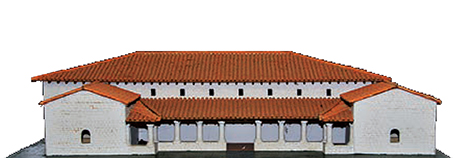
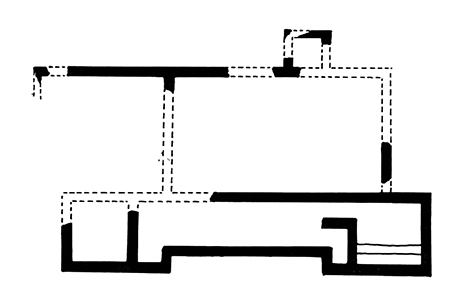 Model and reconstruction drawing of the Gallo-Roman villa in Jette, third century AD
Model and reconstruction drawing of the Gallo-Roman villa in Jette, third century AD
Things changed after the fall of the Roman Empire. Wooden construction re-appeared, resuming pre-Roman traditions.[5] The 19th-century architect Louis Cloquet[6] points out two other evolutions during this period: women were no longer isolated within houses, which now included large openings to the exterior.
Two forms of housing could be found in Brussels in the early Middle Ages. On the one hand, peasant houses, common across the region, displayed a single large quadrangular space organised around a central family hearth.[7] Their construction was rudimentary, with wooden and cob walls capped by large thatched-ridge roofs.
On the other hand, local lords built stone houses – steens in Dutch. In the absence of city walls, these costly houses were designed to protect their residents, as suggested by their stone construction, central towers, and crenelated walls.[8] Such buildings consisted of several floors erected on vaulted basements. Texts mention various steens in Brussels,[9] but none of these noble houses remains today; the last one was destroyed in 1910 during work on the north–south railway connection.[10]
City Housing
Brussels was officially founded around 979,[11] when its first marketplace developed along the Senne River. The real turning point for housing, however, was the construction of the earliest city walls in the 12th century.[12] The aim at the time was to fit as many residents as possible behind the walls; buildings were therefore packed tightly together. In order to be accessible, houses evolved from breedhuis (broadhouses) to diephuis (deephouses) by pivoting to offer their shortest side to the street.[13] Housing consequently developed in depth and height on long and narrow plots of land determined by acknowledging previous (agrarian) divisions, finding an optimum width between facade apertures and beam spans to allow as many dwellings as possible within a limited area.[14] Housing inside the walls developed in two stages: wooden houses followed by brick and stone residences.
Wooden Houses
The first form of urban dwelling in Brussels was the timber-frame house. Although the last example was demolished in 1818,[15] drawings, paintings, and surviving built structures in the surroundings of Brussels give us a good overview of their composition.[16] As in many medieval cities, narrow streets – kattesteghe[17] – were created between properties to prevent fires spreading between wooden constructions. City blocks were therefore permeable, allowing collective uses (drying greens for household linens, orchards, etc.) in their centres.[18] Gutter walls were organised along these kattesteghe, leading to the appearance of gables on the main streets.[19]
The layout of these wooden houses was determined by their reduced street frontage and restricted development in height. Compared with rural houses, urban dwellings had become too narrow for a central hearth, and the constraint of continuous vertical ducts through the different floors led to placing the hearth against party walls. In addition, since light was very scarce in the kattesteghe, large apertures were made on street facades. Houses consisted of two to four floors of similar height usually with two additional floors below the attic.[20] Semi-buried basements were directly accessible from the street through a double door and a staircase. In general, the ground floor was very public, used for commercial or work space as well as a room for family gatherings. The upper floors, connected by a spiral staircase located either inside or outside the building, usually comprised two identical rooms laid out in a row. Due to the narrowness of these buildings, a lifting beam with a pulley was placed on the facade to hoist bulky goods to the upper floors. To allow additional light, a courtyard was placed at the back of the building, where a cesspit and a rainwater tank could be found. Drinking water generally came from public fountains. Within these recurring features, very diverse layouts could be found, usually legible from the outside by the entrance position (centred or not, elevated or not, in the kattesteghe or not).
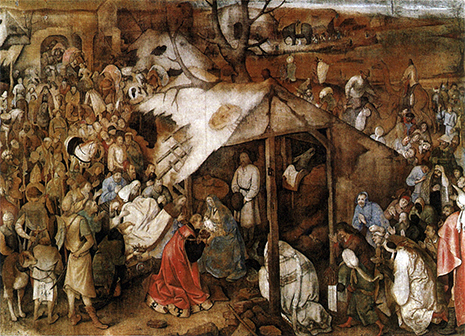 Wooden rural house as depicted by Jan Brueghel the Elder in The Adoration of the Kings, 1598
Wooden rural house as depicted by Jan Brueghel the Elder in The Adoration of the Kings, 1598
Oak wood was used for the structure, facade, and finishing elements. Structurally, each level of a timber-frame house was independent by virtue of having its own wood panelling. From floor to floor, corbels of around half a metre allowed a lighter structure,[21] increasing the floor surface and protecting the street from bad weather. The roofs were supported by “trussed rafters” or “truss and purlin” and presented their triangular gables to the streets. They were capped with thatch, which would later be replaced by clay tiles.[22] Roofs perpendicular to the streets had a major consequence: in the absence of a kattesteghe, adjoining houses shared a common cornice where water and snow accumulated. While wood was the main material, brick and stone were nevertheless used for gutter walls, chimneystacks, cellars, and vaulted basements to protect the wooden structures from humidity. Apertures were split into two registers: glass (when affordable) for the upper parts of the bays and thick wooden shutters for the lower parts.
Timber-frame housing survived in Brussels until the beginning of the 19th century. From the 14th century onwards, however, it was gradually overtaken by the brick house.
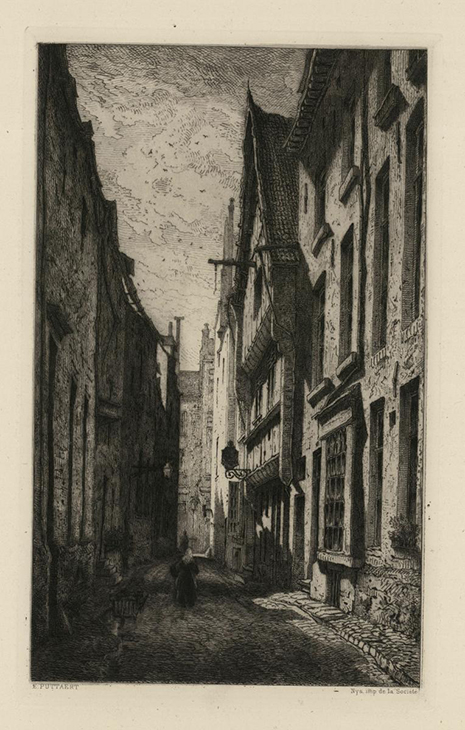 Timber-frame house with corbels in Brussels’ Petite rue des Pierres, aquatint 1875
Timber-frame house with corbels in Brussels’ Petite rue des Pierres, aquatint 1875
Brick Houses
Fires and successive bans on wood construction[23] sounded the death knell for wooden houses; brick gradually gained the upper hand in the 16th century. This shift was not instantaneous: wood remained common for rear facades.[24] The 1695 bombardment of the city by French troops and the resulting fire[25] marked a turning point in construction techniques. The Grand Place is a clear example of this trend – although plot divisions remained unchanged.
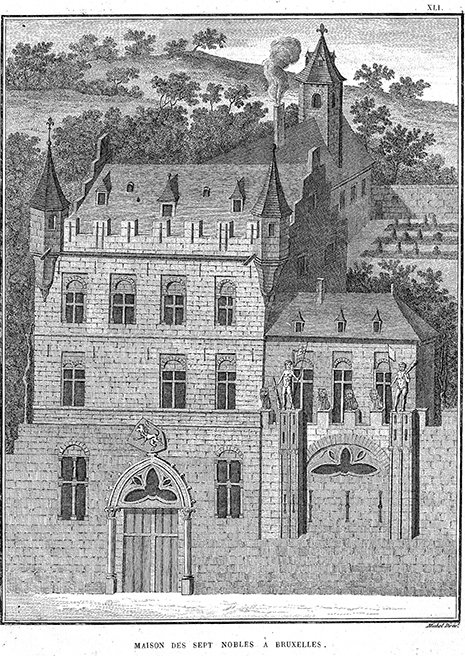 The stone house Sleeuws Steen, in a hypothetical reconstruction by the antiquary Aubin-Louis Millin in 1797
The stone house Sleeuws Steen, in a hypothetical reconstruction by the antiquary Aubin-Louis Millin in 1797
Three major changes occurred with brick construction. First, facade apertures tended to align vertically to avoid overhangs and traction strains brick cannot bear. This is, according to Viollet-le-Duc, the origin of the bay.[26] A later horizontal alignment of the windows would be for stylistic rather than constructive reasons.[27] The overall predominance of voids over solids remained as it had been in wooden facades.[28] Second, kattesteghe became obsolete and were incorporated in the houses, which became strictly terraced. City blocks were thus rendered impervious to the public realm. Third, sharing a common gutter was a recurring source of problems among neighbours due to water infiltration. Consequently, at the end of the 17th century,[29] a local law required rainwater to be collected on the street facade and conducted to the ground. This led to a progressive reversal of the roofs, modifying the physiognomy of streetscapes.
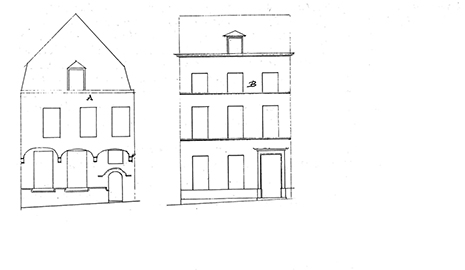 The transformation from timber (left) to brick houses (right) led to vertical window alignment and roof reversal (house transformation by Henri Partoes, Rue d’Accolay in 1819).
The transformation from timber (left) to brick houses (right) led to vertical window alignment and roof reversal (house transformation by Henri Partoes, Rue d’Accolay in 1819).
In terms of layout, staircase position became an important issue in the 16th century. While an exterior staircase requires an enfilade between rooms, an interior one provides a landing allowing access to all rooms independently. At a time when the Counter-Reformation promoted prudishness and privacy, this difference in the articulation of spaces was essential. While an enfilade imposes intimacy among household members, a landing – and corridor, in some cases – allows for independence, a solution favoured from then on in domestic architecture.[30] Interestingly, Le Muet’s housing manual[31] sheds light on possible staircase positions depending on plot widths. Only on those above 5 to 6 metres should the staircase be included within the house, allowing for rooms to be served independently by a landing. It seems therefore that moral concerns, coupled with technical contingencies, led medieval plots to evolve towards greater widths.[32]
Dwelling types other than these widespread forms of ordinary terrace housing could nonetheless be found in Brussels in this period. For instance, two béguinages (housing communities of women living together in closed premises without taking vows) were built in Brussels in the 13th century, one – the Great Beguinage – in the centre, the other in Anderlecht. Although isolated from the city by a perimeter wall, this type of housing was similar to those found elsewhere in town.
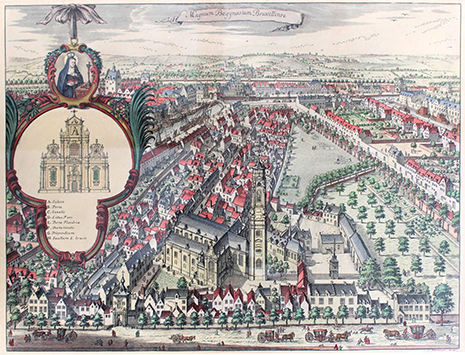 The Great Beguinage built at the centre of Brussels in the 13th century, engraving 1727
The Great Beguinage built at the centre of Brussels in the 13th century, engraving 1727
Two forms of buildings emerged for the upper class. L-shaped buildings,[33] such as the Hôtel Clèves-Ravenstein, displayed a broad façade on the street coupled with a perpendicular building.[34] This arrangement allowed large façades on relatively narrow plots with a courtyard in the centre of the composition. Palaces with courts and gardens, such as the Hôtel Vanderlinden d’Hooghvorst, appeared from the 18th century on. Inspired by French models, the buildings sat between a courtyard one the street side and a garden at the back. Outside densely populated areas, particularly on the “chaussées”,[35] where wider plots could be found, buildings – breedehuis – developed parallel to the street rather than perpendicular to it.
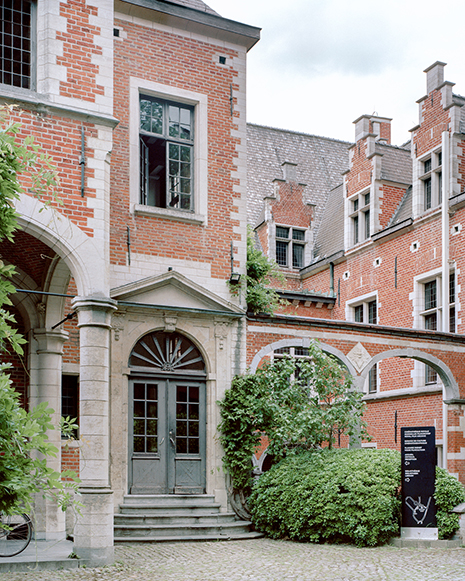 The Hôtel Clèves-Ravenstein from the late 15t century is an example for the L-shaped building type.
The Hôtel Clèves-Ravenstein from the late 15t century is an example for the L-shaped building type.
In terms of construction, brick became common in Brussels from the time of the Roman occupation thanks to easily exploitable outcropping clay deposits.[36] It was also the main material for the second city wall built in the 14th century. Brick factories operated in Brussels until the 18th century.[37] In addition to houses’ vertical structure, partition walls were built of brick from the 16th century onwards. Stone, usually Gobertange limestone and Belgian bluestone, was used for chiselled elements or fragile edges.
Although wood disappeared from the façades, it was still used for staircases, floors, and roof structures. It nevertheless had a lasting influence on the design of facades, which recalled the floor alignment of timber constructions (corbels, bands, and skirting boards) and on the gable tradition that persisted until the 17th century.[38]
As a consequence of the decline of wooden structures, the Sonian Forest at the south-east edge of Brussels, a major supplier of oak, would gradually be transformed into a beech forest from the 17th century on.[39]
Early 19th Century
In the early 19th century, housing underwent radical changes that would lead to the development of a dominant typology at the end of the century: Brussels’ referential type. The referential type can be defined as the archetypal and most ordinary residential type in a particular place. In most cases, it is the residential type commonly built during a demographic boom such as the Haussmann period in Paris or the 18th century in Naples.
In Brussels, the evolution towards a referential type took place in four stages. First, at the beginning of the century, foreign treatises such as Jean-Nicolas-Louis Durand’s[40] had a significant impact on Brussels’ domestic architecture. Moreover, classicism became popular in Brussels, disrupting its medieval image. Several municipal policies tried to unify the urban landscape by whitening and plastering facades.[41] During the French Revolution, the Great Beguinage was sacked and, along with most religious orders, dissolved. The subsequent remodelling of the Great Beguinage by Henri Partoes illustrated the influence of Durand, for instance in his design for the Grand Hospice Houses in 1829.
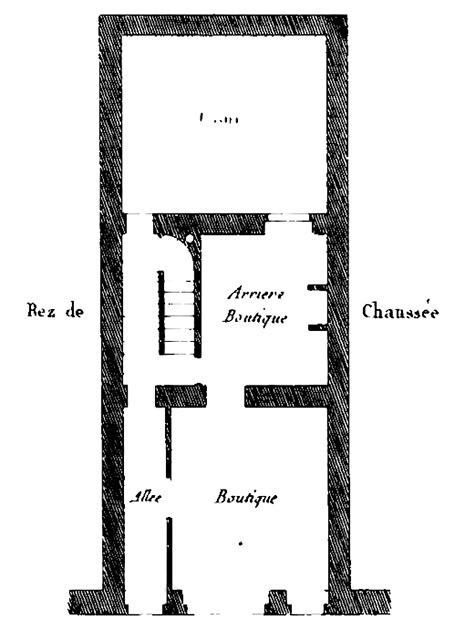 Durand’s layout of a maison à loyer, divided in two longitudinal bays, 1809
Durand’s layout of a maison à loyer, divided in two longitudinal bays, 1809
Ordinary housing was concealed behind the regular and sober facades of two urban palaces. Behind these unifying masks, three-window houses followed a layout similar to Durand’s maison à loyer,[42] dividing the building into two longitudinal bays: the main bay displayed an enfilade of rooms of equivalent size, while the distribution bay included a vestibule, a staircase with a turning flight, and access to the garden.
The houses shared twin entrances, giving the impression of larger residences. They were raised 60 centimetres, offering some natural light to the basement. Latrines were located in the garden, in which no well was visible, probably replaced by the public fountain on the small square in front of the buildings. Finally, despite the fact that they were terraced, the intermediate walls between two houses were not strictly included in a vertical plane as the space above the entrances belonged to only one of the two. This real-estate operation was based on sanitation and modernisation of a poor existing neighbourhood. The same motives led to the transformation in the first half of the 19th century of the area around the small Rue St-Hubert close to the Grand Place into the Galeries Royales Saint-Hubert, 1847, by architect Jean-Pierre Cluysenaar, where housing was combined with retail in a classical passage.
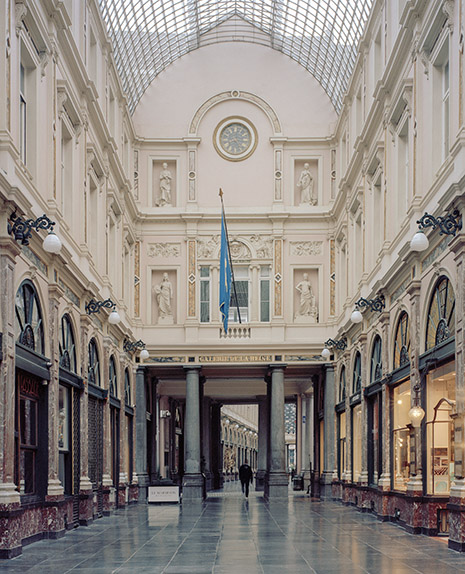 The Galeries Royales Saint-Hubert, Jean-Pierre Cluysenaar, 1847, combines housing with retail in a passage.
The Galeries Royales Saint-Hubert, Jean-Pierre Cluysenaar, 1847, combines housing with retail in a passage.
Ten years after Partoes, Tilman-Francois Suys proposed an urban plan for the Quartier Leopold to house the emerging upper class. In its ideal block (Quartier Léopold Ideal Urban Block), its housing displayed similarities with Partoes’: raised ground floors allowing direct light into basements, two-floor-high houses topped by a gable roof, and a floor plan divided into two uneven longitudinal bays. There were nonetheless significant differences. Unlike the unitary approach taken in Partoes’ beguinage, Suys’ design displayed a great variety between corner and centre buildings in terms of plans, size, expression, exterior spaces, and attached service buildings. The terraced houses had three rooms in a row in the main bay rather than two, with a very narrow central room that seemed uncomfortable to use. The facade expression was no longer repetitive, with clear distinctions between the large and the narrow bays. Single-flight staircases also differed from the beguinage, allowing a horizontal coordination of all windows in the rear facade. Finally, all party walls fit in absolutely vertical planes.
Between 1830 and 1870, the type of the Léopoldian House,[43] named after the first Belgian king, Leopold I (1790–1865), initiated a series of evolutions. The ground floor was no longer elevated, which meant there could be no living spaces in the cellars. The kitchen was located in an annex to the main building, an extension of the distribution bay. The staircase featured two flights of steps, creating an intermediate level on the landing – entresol – under which one had to pass to reach the annex. In the main bay, a veranda punctuated the three-room enfilade on the garden side. Capped with a skylight, this room provided more light for the central room.
Towards the end of the 19th century, facades became more ornamented, reflecting the desires of the newly founded Belgian state’s bourgeoisie. Henri Beyaert’s design for the Hôtel Marnix (1880, demolished in the late 1960s) was a prime example of this eclectic style – Flemish Renaissance – that evoked the past glory of the low countries.[44] Eschewing the classical canons followed by Partoes and Suys, this trend visibly individualised each house. Another case in point was Beyart’s row house Hier ist in den kater en de kat from 1874.
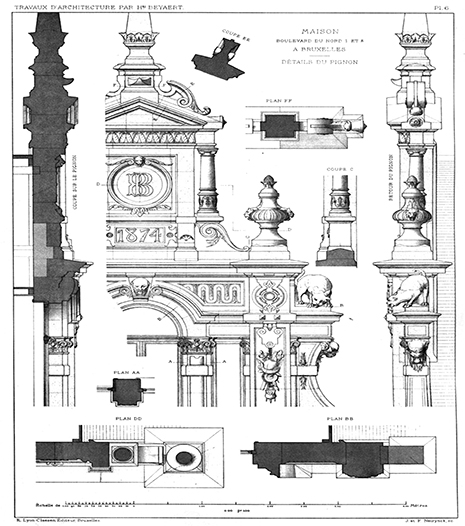 The eclectic façade of the row house Hier ist in den kater en de kat by Henri Beyaert, 1874
The eclectic façade of the row house Hier ist in den kater en de kat by Henri Beyaert, 1874
Façades became more elaborate, eliminating any stylistic unity in streets. Polychromy became more and more pronounced and the use of bluestone was common for plinths and window frames. Additionally, ground floors were raised by between 50 centimetres and 2 metres during that period. Combined with the mandatory implementation of sidewalks (1846) that protected the bases of the walls, large apertures could now be made at ground level, allowing living functions in the basements, something made possible by Brussels’ well-drained sandy subsoil.
Brussels’ Dominant Housing Type: The 1870–1914 Bourgeois Terraced House
From 1870 to 1914, Brussels experienced a golden age.[45] The economy thrived, the population tripled, and Brussels expanded rapidly. Victor Besme, Brussels’ road inspector, proposed an urban plan to accommodate the city’s expansion. His proposal relied on an intersection[46] of public institutions in the form of peripheral boulevard cared for by the public authorities with private housing built by the rising middle class, around whom this plan was centred. The city beyond “the Pentagon” – the city’s second belt of walls – was built according to this arrangement.
In the second half of the 19th century, major technical and social changes forged what would become Brussels’ dominant housing type, the “bonne maison moyenne”.
From a technical point of view, new materials emerged from the industrial revolution: reinforced glass, concrete, metal beams, etc. transformed the art of building. Lighting evolved too, from oil lamps to gas in the 1870s to electricity starting in 1880. From the 1860s, drinking water was supplied directly to buildings via a water-supply network. Subsequently, dedicated pipes and ducts would be installed in houses.[47] This also resulted in a higher specification of the location of water-related rooms such as kitchens and bathrooms, whose furniture had previously been movable. The first sewage systems were installed between 1840 and 1850.[48] With the invention of the siphon and flushing toilets, latrines no longer needed to be located in courtyards; they were installed within the house, where vertical water drainage became a technical constraint that determined housing layouts.
From a socio-cultural point of view, the bourgeois model of the nuclear family spread as a political instrument to tame the working class. Relationships within the household were increasingly codified, among spouses, children, domestic servants, and guests. In this model, intimacy among members of the household was now prohibited, leading to a multiplication of circulation spaces. Social status was now measured by the degree of domestic workers’ invisibility. These social codes were spatialised by local architects such as Louis Cloquet[49] of the newly founded Belgian state’s bourgeoisie.
The Ingredients of the “bonne maison moyenne”
In the 1870s, a synthesis of past housing forms and new domestic uses and construction techniques[50] generated Brussels’ referential housingvtype, one that would not be called into question until the First World War. What Victor Horta also called the “type de la bonne maison moyenne”[51] Remained largely an implicit set of design rules within which architects could produce a large number of variations. These rules can be summarised in four spatial properties.
Interwoven Relationship with Closed Urban Blocks
First, the referential or standard housing type was set in a closed urban block. Compared with those of the Middle Ages, these blocks are smaller and more regular, with 10 to 20 houses on each side. Moreover, they are closed off to the street, as undeveloped land had to be fenced.
Within blocks, plots were structured in a rational way, as perpendicular to the street as possible.
If the average plot width stabilised at around 6 metres, social hierarchies could be read in the built structures: plot widths ranged from 5.8 to 7.2 metres on normal streets and 12 to 16 metres on avenues. In an interwoven relationship, terraced houses formed the perimeter of the blocks, to a depth of 10 to 15 metres. Their party walls extended outdoors to delineate private gardens that form an interior compound, shared visually by the block’s inhabitants.
Polyvalent Interior Layout
The house contained all the spaces necessary for daily bourgeois life, organised according to three modes: reception, family, and domestic service.[52] To accommodate them, the internal layout was based on a double division already seen in Durand’s scheme. An example is the rowhouse Trooz 12, dating to 1914. The plan was divided longitudinally in two uneven parts (⅓, ⅔), creating a main bay of 3 to 4.5 metres and a small bay of 1.6 to 2.1 metres. The house was also partitioned parallel to the street into two to three equivalent adjoining rooms. Their depth, around 4 metres, related to the usual span of wooden beams.[53]
These divisions produced rooms of two distinctive kinds in terms of dimensions. Main rooms had high ceilings, wide windows, and numerous connections to service areas. They were organised in an enfilade. Secondary rooms occupied the narrower bay on either side of the staircase. Within these divisions, a precise hierarchical principle applied, namely a spatial progression from public to private: the deeper, higher, and smaller the space, the more intimate it was.
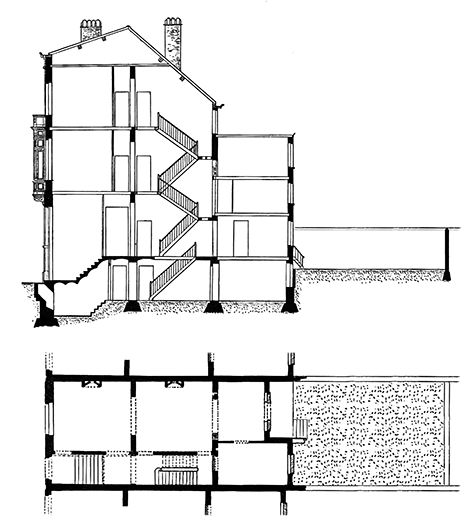 Brussels’ standard housing type in section and plan. The layout is characterised by two to three adjoining rooms and a lateral staircase.
Brussels’ standard housing type in section and plan. The layout is characterised by two to three adjoining rooms and a lateral staircase.
The circulation space was designed to allow for the independence and differentiated uses of these rooms. For instance, the dining room was accessible from the living room for receiving guests, from the corridor for daily use by the family, and from the pantry for service by domestic servants. This circulation was located in the narrow bay. It started with one or two exterior steps leading to the door, which opened into a very high entrance hall of generally more than 5 metres. This vestibule sorted two kinds of traffic. Hidden behind a side door, a wooden staircase gave direct access to a sunken basement where domestic staff were based. Family members and guests used the main staircase, commonly made out of marble on vaulted bricks. It led to the landing of the raised ground floor – bel étage – which was often closed off from the vestibule by a glass door for thermal reasons. On this landing, a moulded portico marked the limit between reception and family life. Before the portico was a door to the reception room, while crossing the portico gave access to the dining room or the two-flight staircase to the upper floors. The first two flights were asymmetrical, however, to allow passage under the first landing. On intermediate landing levels, entresol rooms could be found, which were characterised by lower ceilings; these were naturally used as service spaces. On the upper floors, the landings were ingeniously centred on two adjoining bays to directly serve all rooms.
A closer look at the levels of the house reveals first a half-buried basement that takes direct light from the low windows enabled by the implementation of sidewalks. This floor was the domain of the domestic staff. It housed several functions: in the main bay, a kitchen was connected to the upper floor by a service stair and, often, a dumbwaiter. A coal, wine, or beer cellar and storage and laundry room can be found in the narrow bay. On the rear side, the floor opened up to a courtyard below the garden, whose soil was retained by a rainwater tank. Latrines for the domestic servants were located in this lower courtyard. The long and narrow gardens were flanked by brick party walls that provided privacy from the neighbours.
The bel étage was raised ½ to 2 metres above street level to enhance privacy on the main floor and to admit light into the sunken basement. Reception and family living areas were found in its main bay, with ceiling heights that ranged from 3 to 5 metres.[54] Large mantle pieces against the party walls indicated the centres of the rooms. Given its position on the street side, the living room was naturally the place for receiving guests. This led directly to the dining room, the heart of the family house, while a veranda often concluded the enfilade. This late-19th-century invention can be seen as a direct extension of the garden into the house. It was made possible with the invention of skylights thanks to the iron and glass industries, and the pronounced taste of the bourgeoisie for botany, greenhouses, and exotic plants. Verandas usually had a lower ceiling, enabling direct light to enter the dining room.
Beside the veranda, a lower-ceilinged room, the pantry, created a hinge between the sunken basement and bel étage. The upper floors were the domain of family intimacy. In these rooms, ceiling heights remained high for reasons of both hygiene and light. In keeping with the hierarchical organisation of the house, the main bedroom faced the street. It opened through a double door into a second room on the garden side. In the narrow bay, a smaller room was typically used for daily washing. With the advent of running water, however, bathrooms and toilets would gradually migrate to the entresols.
In the garret, the hierarchical principle distinguished three more spaces. The main room was for guests, in the wide bay facing the street. The narrow room parallel to it was reserved for servants, while an attic occupied the garden side.
Limited Heights and Façades
City blocks bordered directly on streets. Local regulations therefore limited cornice heights to 12 to 14 metres, in direct proportion to the width of the streets.[55] With this limited height, the building volumes were defined by four walls. Two blind brick party walls were built on property limits. On the interior side of the block, the rear wall was not considered a facade in its own right and was subject to the contingencies of the internal layout.
Conversely, the street facades were remarkable for a profusion of decoration consistent with eclecticism. Facades’ designs responded to internal hierarchies: wider windows marked the noble bay, echoing the openings of the longitudinal enfilade. Given the very repetitive floor plans, the facades became the main challenge for architects. Instead of floor plans, they enticed clients with a series of facade variations – cartons.[56] To address the question of associating two very different longitudinal bays as well as different floor heights and the openings of the semi-sunken basement, a set of architecture elements was developed: projecting bands, plinths, copings, balconies, glass transoms, bolt holes, skylights, downpipes, French windows, oriels, spies, letter boxes, facade numbers, cornices, railings, etc. Those playful elements could be picked out of catalogues[57] or designed by the architects themselves. The bow window was a characteristic feature of the 19th-century facade. It marked the social status of the building while allowing light and side views on the street. Curiously, it was rarely a part of the bel étage, the building’s most imposing floor, as was the case in the English house. This anomaly can be explained by local regulations on protruding elements as well as the overall balance of the facade. In terms of materials, craft and industry mingled, with polychrome composite and relief masonry, natural stone, richly sculpted woodwork, elaborate ironwork, prefabricated cast-iron elements, etc. The facades became the place for all kinds of extravagance, as shown by the competitions organised at the end of the 19th century, leading to an incredible diversity of cityscapes.
In addition to those challenges were fire-prevention regulations, forbidding the thick brick party walls from bearing the loads of the building. The load-bearing walls were therefore the facades and the partition walls of the enfilade, whose thicknesses were also codified. In terms of uses, this system was contradictory, since facades and partition walls were largely open to let light in and allow people to move around. These openings were made possible by a combination of relief vaults and metal lintels scattered throughout the walls. Two exceptions appeared, however. The roof structure was made of purlins that bore on the party walls. As such, they were one of the determining elements of the plot width that corresponded to the usual span of northern red-pine wood sections. The ground floor also presented a different structure. Thanks to the reduction of the party walls’ thickness between the basement and the bel étage, it was possible to lay wooden beams directly on this recess without embedding them in the walls.
Individual Character
The last defining feature of the bourgeois terraced house was its individual aspect. Initially, buildings were designed for single families with domestic servants. They emphasised Belgian society’s individualistic nature and great sense of autonomy. Each house accommodated a single household and the facades expressed this individual character as emphatically as possible, leading to very heterogeneous streets. This feature clearly distinguishes Brussels from other “cities of houses” such as London, Bath, or Amsterdam, where on the facades a sense of collectivism prevails over individual expression.
Altogether, these four features – i.e. the relationship with the closed urban block, the polyvalent layout, the height limitation determining the facade, and its individuality – defined the most common housing type in Brussels, its referential type.[58]
Variations on the Dominant Type
Within these four basic features, there could be variations in plot width, position in the block, and the social status of the residents. Differences in social status were reflected in plot widths. While the standard type accommodated the middle class, certain variations signalled residents’ wealth. More complex layouts were designed for the better-off classes, for instance the terraced house at Molière 112 from 1907 by Paul Picquet. Housing was built on larger plots, enabling the service bay to expand with a carriage entrance and service staircase, separating family and domestic service flows even more. For the working classes, individual housing was built on narrower plots,[59] offering a reduced version of the referential type deprived of its reception and service functions. This transposition to popular housing[60] reflected the bourgeois desire to dominate the working class by imposing its own way of life through architecture. Isolated in individual housing, workers lost the communal life found in the bataillons carrés, a type of housing gathered around a courtyard or a small street that had developed in the interior of old city blocks, accessible only by a dead-end street, such as Impasse Vanhoeter, from 1848, by architect C. Vanhoeter. Another variation on the referential type was small-scale private development, with apartment buildings designed on two adjoining plots. These apartment buildings retained the facade design of the individual traditional housing type. Only the respectable image of the type was maintained, however, as each room independently accommodated a family, with shared bathrooms on the entresols.
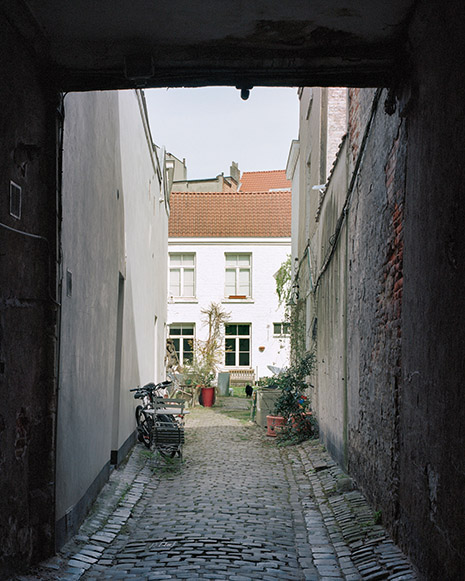 Worker housing in a dead-end street: Impasse Vanhoeter, from 1848, by architect C. Vanhoeter
Worker housing in a dead-end street: Impasse Vanhoeter, from 1848, by architect C. Vanhoeter
Other differences could be found within the usual 6-metre-wide plot. When shops occupied the ground floor of the houses, they were naturally on street level, precluding any living functions in the basement. The requirement for two entrances – one for the dwelling, the other for the shop – allowed the facade to be symmetrical. More modest houses were also built on the usual plot width. They usually did not have a bel étage, but at most one or two steps that allowed some privacy from the street. To light the basement, window wells were created in the pavement. Some of these modest houses had only two adjoining rooms and no veranda.
Corner plots had a special status since they allowed little or no access to the interior of the block. Three approaches to the corner location can be observed. The first created an avatar of the referential housing type, with additional openings in the side wall. In some extreme cases, however, the design ignored the corner position by favouring one street over the other by presenting a blind facade, often with walled windows. In other cases, the openings on the secondary street were freer.
The plan then combined the typical enfilade with a more random composition. Some corner buildings had a garden or courtyard facing the street rather than the interior of the block. In this case, a wall protected the courtyard from the road. Finally, another approach included a shop on the ground floor and flats on the upper floors, as evidenced by the apartment building on Berkendael 203, 1909, by architect Joseph Diongre. It is interesting to note that, given their particularities and need for inventive layouts, corner parcels were the last to be built to close off the blocks.[61]
Other atypical plots could be found in a block. For instance, some were completely closed off on three sides by other buildings, forcing them to get all their light from the street, as in the case of the architect Victor Taelemans’ personal house on Rue Ernest Solvay 32. Some plots located near block corners gave onto two different streets, allowing two entrances as well as very different atmospheres in the house.
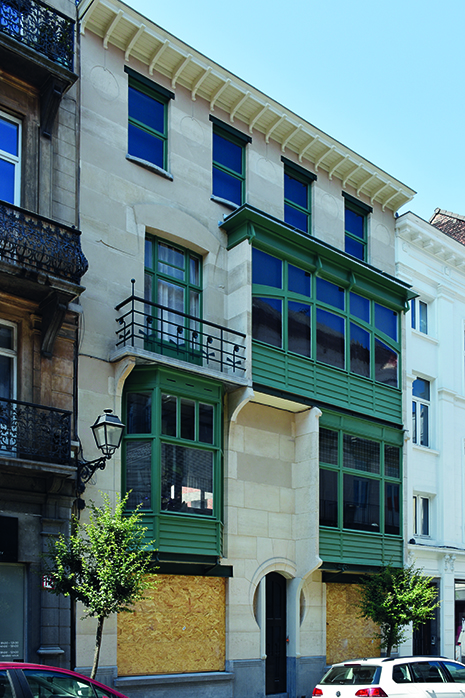 The terraced house on Rue Ernest Solvay 32, Victor Taelemans, 1904, is lit via three large baywindows.
The terraced house on Rue Ernest Solvay 32, Victor Taelemans, 1904, is lit via three large baywindows.
Implementation of the Dominant Type
An unprecedented building frenzy took place between 1870 and 1914. A road network based on Besme’s plan structured the city and its buildings. Accordingly, new roads were quickly laid out and put in place even before the first houses were built. It was not uncommon at the time to see free-standing terraced houses in streets that were entirely paved, surrounded by pavements and bristling with lampposts.
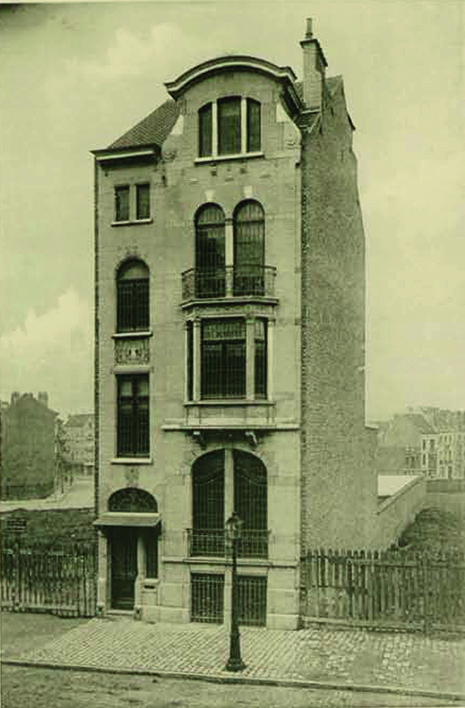 Free-standing Brussels terraced house, a pioneer of further projected development
Free-standing Brussels terraced house, a pioneer of further projected development
In many cases, individuals built their own houses; speculation was nevertheless the real driver of Brussels’ expansion. Besme himself supported this movement and did not hesitate to advise relatives to purchase land he knew to be earmarked for development.<a id=”fn-a-62” href=”#fn-b-62“>[62]</a> Real-estate developers built in the hope of reselling or renting out their properties. Homeowners didn’t necessarily live in their houses, which had become commodities. The vast majority of these developers were private. Such developments usually involved individual houses or city blocks, but tycoons such as Georges Brugmann and Edmond Parmentier constructed entire districts. A few public operations were also undertaken. For instance, the SABH[63] built an entire city block in Schaerbeek in 1875 based on plans by Gédéon Bordiau, the Cité Louvain with 166 flats. Despite the larger scale of these developments, however, the standard type and its individual character persisted.
The Terraced House Today
Brussels’ identity is closely tied to its referential type, the bourgeois terraced house, which is still its most common form of housing. Currently, approximately 140,000 houses built before 1918 are still standing[64] and more than one-third of the dwellings in the city are in houses built between 1870 and 1914.[65]
In addition to this quantitative representativeness, the individual terraced house enjoys tacit recognition in the local residential imagination. Its spatial organisation also mirrors and supports local socio-cultural relations. In this way, the domestic space of the city can be read as meaningful.[66] In Brussels, an analysis of the features of the referential housing type reveals a series of socio-anthropological elements that characterise the city. First, front and rear positions created by closed blocks enable contrasting dwelling arrangements, a typical feature of many European cities, although with large variations.[67]
While public practices take place on the street side, very private ones (ranging from drying clothes to self-built additions) are possible at the rear of the dwelling. Secondly, even on a building’s highest floor, the distance to the public realm remains limited to about 15 metres, a threshold within which sensory relationships are still possible.[68] Thirdly, the individual character of the dwellings emphasises the individualistic nature of Belgian society. Indeed, Belgian citizens demonstrate a great sense of autonomy regarding political authority and collective efforts. Finally, the function-free floor plan reveals traditional Brussels households’ socially conditioned relations. The plan enables a genuine hierarchy within the dwelling (front/back positions, small/large rooms, low/high situation) as well as various possible relations between occupants through a variety of circulation spaces. Interestingly, the house only displays two sizes of room, which would prove extremely polyvalent in the century that follows.
Footnotes
Known as diverticula. “The ‘Roman road’ in Wemmel, the ‘Dieweg’ in Uccle, the ‘Rue Haute’ and the ‘Chaussée de Haecht’ in Brussels would be the distant evidence of this.” Martiny, Victor-Gaston. Bruxelles: architecture civile et militaire avant 1900. Brussels, J.M. Collet, 1992, p. 12.
Remains of Roman villas have been found in the Brussels municipalities of Anderlecht, Laeken, and Jette. Matthys, André. “La villa gallo-romaine de Jette.” Archeologica Belgica, vol. 2, no. 152, 1972, pp. 7–37.
Charruadas, Paulo. “De la campagne à la ville. Peuplement, structures foncières et croissance économique dans la région de Bruxelles avant l’an mil.” Medieval and Modern Matters, vol. 2, 2011, pp. 1–24.
Cloquet, Louis. Traité d’architecture. Eléments de l’architecture. Types d’édifices. Esthétique. Composition et pratique de l’architecture. vol. 4, Liège, Ch. Béranger, 1900; Matthys, André. “La villa gallo-romaine de Jette.” Archeologica Belgica, vol. 2, no. 152, 1972, pp. 7–37.
Following the invasions from the north, Gauls resumed their tradition of building with wood. Viollet-le-Duc, Eugène. Dictionnaire raisonné de l’architecture française du XIe au XVIe siècle. vol. 6, Paris, Bance, 1863, p. 214.
Cloquet, Louis. Traité d’architecture. Eléments de l’architecture. Types d’édifices. Esthétique. Composition et pratique de l’architecture. vol. 4, Liège, Ch. Béranger, 1900, p. 2.
van de Walle, Adelbrecht. Het bouwbedrijf in de Lage Landen tijdens de middeleeuwen. Antwerp, De Nederlandsche Boekhandel, 1959.
Verniers, Louis. Un millénaire d’histoire de Bruxelles: depuis les origines jusqu’en 1830. Brussels, de Boeck, 1965, pp. 77–78.
Valkenborgsteen, Ketelsteen, Meynaersteen, Machiaensteen Martiny, Victor-Gaston. Bruxelles: architecture civile et militaire avant 1900. Brussels, J.M. Collet, 1992, p. 14; Henne, Alexandre and Alfonse Guillaume Ghislain Wauters. Histoire de la ville de Bruxelles. Perichon, 1845, vol. 1, pp. 22–23; Millin, Aubin-Louis. Antiquités nationales ou Recueil de monuments pour servir à l’histoire générale. vol. 5, Paris, Drouhin, 1797.
Martiny, Victor-Gaston. Bruxelles: architecture civile et militaire avant 1900. Brussels, J.M. Collet, 1992, p. 14.
CERAA. Morphologie urbaine à Bruxelles. Brussels, CERAA, 1987.
Bonenfant, Paul. “Les premiers remparts de Bruxelles.” Annales de la Société Royale d’Archéologie de Bruxelles, vol. XL, 1936, pp. 7–47; Deligne, Chloé. Bruxelles et sa rivière. Genèse d’un territoire urbain (12e-18e siècle). Turnhout, Brepols Publishers, 2003. Studies in European Urban History.
Martens, Mina and Victor-Gaston Martiny. Histoire de Bruxelles. Privat, 1976; Martiny, Victor-Gaston. “La maison bourgeoise unifamiliale a facade etroite, du 16ème siecle a l’aube du 20ème a Bruxelles.” New Approaches to Living Patterns, edited by Roland Baetens, Anvers, Brepols Publishers, 1991, pp. 109–146.
The most common plot width in the Middle Ages was around 6 metres. Cabestan, Jean-Francois. La conquête du plain-pied: l’immeuble à Paris au XVIIIe siècle. Paris, Picard, 2004, p. 203.
Cloquet, Louis. Les maisons anciennes en Belgique. Gand, Victor van Doosselaere, 1907.
Together with other wooden constructions from Belgium, this house was illustrated by Grabbe and Colinet. Grabbe, Ernst. “Der flämische Holzbau.” Zeitschrift für Bauwesen, 1919, pp. 613–638; Colinet, Emile. Recueil des restes de notre art national. Colinet, 1872. vol. 1.
Viollet-le-Duc also refers to these streets as “ambitus” or “endronne”. Martiny, Victor-Gaston. “La maison bourgeoise unifamiliale a facade etroite, du 16ème siecle a l’aube du 20ème a Bruxelles.” New Approaches to Living Patterns, edited by Roland Baetens, Anvers, Brepols Publishers, 1991, pp. 109–146.
As can be seen on Joan Blaeu’s 1649 map of Brussels.
Viollet-le-Duc, Eugene. Dictionnaire raisonné de l’architecture française du XIe au XVIe siècle. vol. 6, Paris, Bance, 1863, p. 225.
“The very high gable roof represents up to half the height of the building (compared to one third in Paris); there are two floors of rooms opening onto the street through small rectangular windows piercing a vast stepped or curved gable.” Bertrand, Jean-Michel. Architecture de l’habitat urbain: la maison, le quartier, la ville. Paris, Dunod, 1980, p. 15.
Cloquet, Traité d’architecture. Eléments de l’architecture. Types d’édifices. Esthétique. Composition et pratique de l’architecture. vol. 4, Liège, Ch. Béranger, 1900, p. 49.
Houbrechts, David. “Les maisons en pan-de-bois de la Grand-Place.” Les maisons de la Grand-Place de Bruxelles, edited by Vincent Heymans et al., Brussels, CFC editions, 2007, pp. 25–37, p. 33.
1342: ban on thatched roofs; 1465: ban on wooden façades; 1466: ban on maintaining wooden façades, etc. Eloy, Marc et al. Influence de la législation sur les façades bruxelloises. Brussels, C.A.R.A./C.F.C., 1985.
van de Castyne, Oda. L’architecture privée en Belgique dans les centres urbains aux XVIe et XVIIe siècles. Brussels, M. Hayez, Imprimeur de l’Académie royale de Belgique, 1934, p. 38.
This date is a milestone for iconographic resources since most of the archives perished in the fire following the bombardment. Martiny, Victor-Gaston. Bruxelles: l’architecture des origines à 1900. Brussels, Nouvelles Editions Vokaer, 1980.
Viollet-le-Duc, Eugene Emmanuel. Dictionnaire raisonné de l’architecture française du XIème au XVIème siècle. vol. 3, Paris, Morel, 1875, pp. 190–191.
Cabestan, Jean-Francois. La conquête du plain-pied: l’immeuble à Paris au XVIIIe siècle. Paris, Picard, 2004.
Gautier, Patrice et al. “Recherche archéologique d’une maison et de son achterhuis sises rue des Chapeliers 22–24 a 1000 Bruxelles [BR392-02].” Musées royaux d’Art et d’Histoire, 2018.
Eloy, Marc et al. Influence de la législation sur les façades bruxelloises. Brussels, C.A.R.A./C.F.C., 1985.
Robin Evans expands on the invention of the corridor as a means for household members to be able to avoid one another. Evans, Robin. “Figures, Doors and Passages.” Architectural Design, 1978, pp. 267–277.
Le Muet, Pierre. Manière de bien bastir pour toutes sortes de personnes. Paris, François Langlois, 1647.
If 6 metres (three toises) was optimal, most medieval houses were nonetheless far narrower. Cabestan, Jean-François. La conquête du plain-pied : l’immeuble à Paris au XVIIIe siècle. Paris, Picard, 2004; van de Castyne, Oda. L’architecture privée en Belgique dans les centres urbains aux XVIe et XVIIe siècles. Brussels, M. Hayez, Imprimeur de l’Académie royale de Belgique, 1934.
Cloquet, Louis. Traité d’architecture. Eléments de l’architecture. Types d’édifices. Esthétique. Composition et pratique de l’architecture. vol. 4, Liège, Ch. Béranger, 1900.
Ibid.; Martiny, Victor-Gaston. “La maison bourgeoise unifamiliale à façade étroite, du 16ème siècle à l’aube du 20ème à Bruxelles.” New Approaches to Living Patterns, edited by Roland Baetens, Anvers, Brepols Publishers, 1991, pp. 109–146.
Chaussées, or steenwegen, were major medieval roads linking one city to another.
Two types of clay are present in Brussels at the Paniselian and Ypresian layers of the Lower Eocene. Geological map of Belgium, Military Cartographic Institute, 1893.
Such factories were banned in Brussels from 1776. Martiny, Victor-Gaston. “La maison bourgeoise unifamiliale à façade étroite, du 16ème siècle à l’aube du 20ème à Bruxelles.” New Approaches to Living Patterns, edited by Roland Baetens, Anvers, Brepols Publishers, 1991, pp. 109–146, p. 130.
van de Castyne, Oda. L’architecture privée en Belgique dans les centres urbains aux XVIe et XVIIe siècles. Brussels, M. Hayez, Imprimeur de l’Académie royale de Belgique, 1934.
Roland, Lee. “Quand les arbres cachent la ville. Pour une analyse conjointe de la forêt de Soignes et du fait urbain.” Brussels Studies, no. 60, 2012, p. 10.
Durand, Jean-Nicolas-Louis. Précis des leçons d’architecture données à l’école polytechnique. vol. 2, Paris, Ecole polytechnique, 1809.
Although officially, façades were whitewashed for hygiene reasons, the main aim was to give a unified image to the streets of Brussels. Eloy, Marc et al. Influence de la législation sur les façades bruxelloises. Brussels, C.A.R.A./C.F.C., 1985.
Coekelberghs, Denis et al. Un ensemble néo-classique à Bruxelles: le Grand Hospice et le quartier du Béguinage. Institut royal du patrimoine artistique, Ministère de la communauté française, 1983.
Martiny, Victor-Gaston. “La maison bourgeoise unifamiliale a facade etroite, du 16ème siecle a l’aube du 20ème a Bruxelles.” New Approaches to Living Patterns, edited by Roland Baetens, Anvers, Brepols Publishers, 1991, pp. 109–146.
Beyaert, Henri. Travaux d’architecture exécutés en Belgique. vol. 1, Brussels, Lyon-Claessen, 1894; Castermans, Auguste. Parallèle des maisons de Bruxelles et des principales villes de la Belgique. Liège, Noblet, 1854; Loze, Pierre. La maison Blondel de Henri Beyaert, 1886: 11 rue Potagère à Saint-Josse-ten-Noode, Bruxelles. Brussels, Éditions A.P.A.-C.I.D.E.P, 1993
Ledent, Gérald. “Genèse de la maison bruxelloise.” Montréal et Bruxelles en projet[s]. Les enjeux de la densification urbaine, edited by Priscilla Ananian and Bernard Declève, Louvain-la-Neuve, PUL, 2017, pp. 127–156.
Zitouni, Benedikte. Agglomérer. Une anatomie de l’extension bruxelloise (1828–1915). Maldegem, VUB-Press, 2010.
Heymans, Vincent. Les dimensions de l’ordinaire: la maison particulière entre mitoyens à Bruxelles. Paris, L’Harmattan, 1998.
Abeels, Gustave. Pierres et rues: Bruxelles, croissance urbaine, 1780–1980: exposition. Brussels, La société générale de banque, St.-Lukasarchief v.z.w, 1982, p. 29.
Cloquet, Louis. Traité d’architecture. Eléments de l’architecture. Types d’édifices. Esthétique. Composition et pratique de l’architecture. vol. 4, Liège, Ch. Béranger, 1900.
Devillers, Christian. “Typologie de l’habitat et morphologie urbaine.” L’architecture d’aujourd’hui, vol. 174, 1974, pp. 18–22; Ledent, Gérald and Olivier Masson. “Living Utopia – Leaving Utopia. Brussels: Modernist Urban Forms Evaluated against Pre-Existing Row Houses.” Cities in Transformation – Research & Design, Politecnico di Milano, 2012.
Dulière, Cécile. Victor Horta, mémoires. Brussels, Ministère de la Communauté française de Belgique: Administration du Patrimoine culturel, 1985, p. 34.
Cloquet, Louis. Traité d’architecture. Eléments de l’architecture. Types d’édifices. Esthétique. Composition et pratique de l’architecture. vol. 4, Liège, Ch. Béranger, 1900, pp. 40–44.
Burniat, Patrick. “Le type de la maison urbaine bruxelloise.” Bruxelles Patrimoines, vol. 3–4, September 2012.
For these rooms, Julien Guadet and Louis Cloquet recommend a minimum width of 4 metres. Cloquet, Louis. Traité d’architecture. Eléments de l’architecture. Types d’edifices. Esthétique. Composition et pratique de l’architecture. vol. 4, Liège, Ch. Béranger, 1900; Guadet, Julien. Eléments et théorie de l’architecture. vol. 2, Paris, Aulanier et Cie, 1904, pp. 13–14.
Eloy, Marc et al. Influence de la législation sur les façades bruxelloises. Brussels, C.A.R.A./C.F.C., 1985, p. 4.
Bastin, Christine et al. Le XIXe siècle en Belgique: architecture et intérieurs. Brussels, Racine, 1994.
Just like IKEA catalogues today, such catalogues were used by architects and clients. Fonteyne, Jules. Documents pratiques d’architecture. Brussels, Bourotte, 1876; Herman, Joseph. Modern Kunstsmeedwerk. Amsterdam, Ahrend en zoon, 1904.
In the Album de la Maison Moderne, Fernand Salmain pictures these early-20th-century houses, and their great variety, although systematically based on similar plans. Salmain, Fernand. Album de la maison moderne. Brussels, 1908–1913, vol. 1–5.
At the turn of the 20th century, Emile Demany produced a manual with standard floor plans for worker’s housing in Belgium. Demany, Emile. Construction de maisons ouvrières: notice, plans, évaluations & conditions. 2 ed., Liège, Vaillant-Carmanne, 1899.
The standard plan recommended by the 1852 Congress for Public Hygiene proposed “an entrance, two rooms and an annex on the ground floor, two bedrooms on the first floor and an attic, sometimes converted into an attic room under the roof”. Smets, Marcel. L’avènement de la cité-jardin en Belgique, Histoire de l’habitat social en Belgique de 1830 à 1930. Liège, Pierre Mardaga, 1977. Collection Architecture + Documents, p. 51.
In this respect, these corners function as a block’s keystones. Modernist planners in the 1950s through the 1980s clearly understood this when they systematically razed corner buildings in the hope of initiating the decline of the block as a whole. Conversely, works undertaken within the framework of the “contrats de quartier” (Neighbourhood Contracts) are particularly concerned with their reconstruction.
Such as the banker Andre Langrand-Dumonceau, who was advised by Victor Besme to buy hectares of land around the avenue Louise before the avenue was created. Smets, Marcel. L’avènement de la cité-jardin en Belgique, Histoire de l’habitat social en Belgique de 1830 à 1930. Liège, Pierre Mardaga, 1977. Collection Architecture + Documents, p. 40.
Originally the “Société Anonyme des Habitations Ouvrières dans l’Agglomération Bruxelloise”, founded in 1868 by Leopold II.
Heymans, Vincent. Les dimensions de l’ordinaire: la maison particulière entre mitoyens à Bruxelles. Paris, L’Harmattan, 1998, p. 10.
In 2014, out of 546,118 housing units in the Brussels region, 195,831 dwellings were located in terraced houses. This figure is certainly underestimated, as informal divisions of such houses are very common. Ledent, Gerald. “Potentiels Relationnels. L’aptitude des dispositifs physiques de l’habitat à soutenir la sociabilité. Bruxelles, le cas des immeubles élevés et isolés de logement.” LOCI, UCLouvain, 2014; RBDH. “Quotas de logements sociaux: les idées à retenir, les écueils à éviter.” Art.23, no. 38, 2010, p. 9.
Devillers, Christian. “Typologie de l’habitat et morphologie urbaine.” L’architecture d’aujourd’hui, vol. 174, 1974, pp. 18–22.
Panerai, Philippe et al. Analyse Urbaine. Mercuès, Parenthèse, 2009. Eupalinos.
Alexander, Christopher et al. A Pattern Language: Towns, Buildings, Construction. New York, Oxford University Press, 1977, p. 118.
Internal Links
Originally published in: Gérald Ledent, Alessandro Porotto, Brussels Housing. Atlas of Residential Building Types, Birkhäuser, 2023. Edited for Building Types Online.